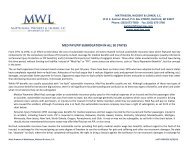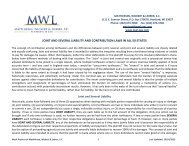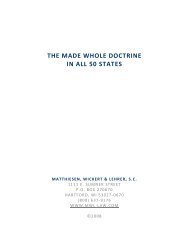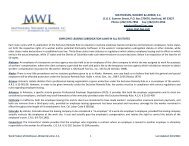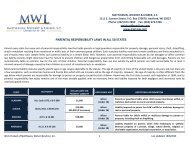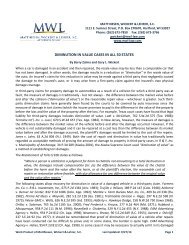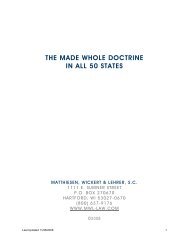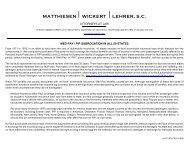Newsletter-January-2.. - Matthiesen, Wickert & Lehrer
Newsletter-January-2.. - Matthiesen, Wickert & Lehrer
Newsletter-January-2.. - Matthiesen, Wickert & Lehrer
You also want an ePaper? Increase the reach of your titles
YUMPU automatically turns print PDFs into web optimized ePapers that Google loves.
MATTHIESEN, WICKERT & LEHRER, S.C.<br />
A FULL SERVICE INSURANCE LAW FIRM<br />
1111 E. Sumner Street, P.O. Box 270670, Hartford, WI 53027-0670<br />
(800) 637-9176 (262) 673-7850 Fax (262) 673-3766<br />
http://www.mwl-law.com<br />
MONTHLY ELECTRONIC SUBROGATION NEWSLETTER JANUARY 2009<br />
TO CLIENTS AND FRIENDS OF MATTHIESEN, WICKERT & LEHRER, S.C.:<br />
This monthly electronic subrogation newsletter is a service provided exclusively to clients and friends of <strong>Matthiesen</strong>, <strong>Wickert</strong> &<br />
<strong>Lehrer</strong>, S.C. The vagaries and complexity of nationwide subrogation have, for many lawyers and insurance professionals, made<br />
keeping current with changing subrogation law in all fifty states an arduous and laborious task. It is the goal of <strong>Matthiesen</strong>, <strong>Wickert</strong><br />
& <strong>Lehrer</strong>, S.C. and this electronic subrogation newsletter, to assist in the dissemination of new developments in subrogation law<br />
and the continuing education of recovery professionals. If anyone has co-workers or associates who wish to be placed on or<br />
removed from our e-mail mailing list, please provide their e-mail addresses to Rose Thomson at rthomson@mwl-law.com. We<br />
appreciate your friendship and your business.<br />
IN THIS ISSUE . . . .<br />
Arkansas Supreme Court Confuses Subrogation with Statutory Reimbursement Right:<br />
Ryder v. State Farm Mut. Auto. Ins. Co., 268 S.W.3d 298 (Ark. 2007) .......................................... 1<br />
Georgia Workers’ Compensation Subrogation Primer ......................................................... 3<br />
Subrogating Livestock/Vehicle Collisions in Idaho ............................................................ 3<br />
The Societal Benefits of Workers’ Compensation Subrogation . . . . . . . . . . . . . . . . . . . . . . . . . . . . . . . . . . . . . . . . . . . . . . . . . . 6<br />
Workers’ Compensation Subrogation In All 50 States (Fourth Edition) Soon to be Released!!! ......................... 8<br />
Upcoming Events ..................................................................................... 8<br />
WORKERS’ COMPENSATION SUBROGATION<br />
ARKANSAS SUPREME COURT CONFUSES SUBROGATION<br />
WITH STATUTORY REIMBURSEMENT RIGHT<br />
Ryder v. State Farm Mut. Auto. Ins. Co., 268 S.W.3d 298 (Ark. 2007)<br />
With increasing frequency, the dire need to educate the American judiciary on the fundamentals of<br />
subrogation and the distinct differences between subrogation and statutory rights of reimbursement, has<br />
become more and more apparent. The Arkansas Supreme Court’s recently-published decision in Ryder v.<br />
State Farm is a bright-line example.<br />
On March 7, 2005, Crystal Ryder and Ronald Froud were involved in an automobile accident in Washington<br />
County, Arkansas. Ryder sued Froud for negligence, claiming property damage and personal injuries. The<br />
two settled the claim for $15,000. State Farm Mutual Automobile Insurance Company, Ryder's automobile<br />
insurance carrier, claimed an interest in the settlement proceeds due to its payment of $5,000 in medical<br />
benefits on Ryder's behalf. Ryder filed a motion claiming that the proposed settlement amount between<br />
Ryder and Froud did not make Ryder whole and asking the court to dismiss State Farm’s intervention. State<br />
Farm asked the court to determine its “subrogation rights” and asserted that it was entitled to reimbursement<br />
for the $5,000 it paid in medical payments coverage on behalf of Ryder, less the cost of collection.
State Farm claimed that § 23-89-207, the statute at issue in this case, provides it with a statutory right of<br />
reimbursement, not a right of subrogation, and therefore, the made whole doctrine should not be applicable.<br />
Section 23-89-202 reads as follows:<br />
(a) Whenever a recipient of benefits under § 23-89-202(1) and (2) recovers in tort for injury,<br />
either by settlement or judgment, the insurer paying the benefits has a right of reimbursement<br />
and credit out of the tort recovery or settlement, less the cost of collection, as defined.<br />
Noting that the statute gave State Farm an automatic right to be reimbursed, rather than a simple right of<br />
subrogation, State Farm argued that it should be able to take advantage of its right of reimbursement<br />
regardless whether its insured had been made whole.<br />
Arkansas Capitol Building<br />
located in Little Rock<br />
State Farm’s argument is well-founded. States have begun to recognize the<br />
distinct difference between subrogation and reimbursement rights. In Wisconsin,<br />
§ 10<strong>2.</strong>29 grants a workers’ compensation carrier a statutory right of<br />
reimbursement, essentially stating that any third party settlement or recovery<br />
must be allocated according to a specific formula which allows the compensation<br />
carrier to be reimbursed without regard to whether the worker has been made<br />
whole. The Wisconsin Court of Appeals has appropriately noted in Campion v.<br />
Montgomery Elevator Co., 493 S.W.2d 244 (Wis. App. 1992), that the carrier’s<br />
rights of reimbursement under § 10<strong>2.</strong>29 is not a subrogation right. It stated that<br />
rights of reimbursement are simple requirements set forth by the legislature (as<br />
the Arkansas legislature set forth in § 23-89-202). It stated that when a carrier is granted a direct cause of<br />
action (for reimbursement or subrogation), this is not the same as merely “stepping into the shoes” of an<br />
insured. Rather, it is much stronger and should be protected more, especially against “equitable” defenses<br />
to mere subrogation such as the made whole doctrine. The Wisconsin Court of Appeals noted that nowhere<br />
in § 10<strong>2.</strong>29 does the word “subrogation” even appear. It noted that a waiver of subrogation is not effective<br />
to waive a workers’ compensation carrier’s rights under § 10<strong>2.</strong>29 because it is not a right of subrogation.<br />
Simple enough.<br />
Apparently it wasn’t that simple for the Arkansas Supreme Court, who clearly decided<br />
the outcome they wanted – defeating subrogation – and found a way to deliver. Tired,<br />
anecdotal and erroneous notions of the often misunderstood “equitable” concept of<br />
subrogation are hard to battle. The first mistake many courts make is that they call it<br />
an “equitable” doctrine even when it is required in writing (e.g., policy terms). This<br />
error has all but destroyed subrogation in states like Georgia. And, then like the cow<br />
following the butt-end of the cow ahead of it, court after court read the mistake-riddled<br />
precedents and restate old and erroneous law, which is precisely what happened in<br />
this case. Arkansas law is clear that § 23-89-202 does not provide a separate cause of action in favor of the<br />
Med Pay carrier against a third party tortfeasor and could not split its insured’s cause of action – a hallmark<br />
attribute of subrogation. So, the reimbursement right that has none of the attributes of subrogation is<br />
deemed to be subrogation despite the word not even appearing in the statute. Sounds like somebody had<br />
an anti-subrogation agenda to fulfill.<br />
Section 23-89-202 grants the Med Pay carrier a statutory lien (spelled out clearly in the statute) and a right<br />
of reimbursement. I would ask the Arkansas Supreme Court what they think the Arkansas legislature should<br />
have written into the statute to be clearer about the Med Pay carrier’s rights of recovery. The court tried to<br />
pound the square hole into the round peg by claiming that Arkansas courts had defined subrogation as:<br />
Subrogation is the substitution of one party for another. The party asserting subrogation is<br />
making a demand under the right of another. Subrogation is a normal incident of indemnity<br />
insurance. That is to say that because insurers pay the obligations to their insureds, a right<br />
in equity to subrogation in the insurer arises. This assures against unjust enrichment by way<br />
of double recovery.<br />
2
And their point is? There has been no substitution of one party for another under § 23-89-20<strong>2.</strong> Likewise,<br />
there has been no demand by the Med Pay carrier under the right of the insured – in fact, the demand is<br />
made ON the insured! While subrogation may be a “normal incident” of indemnity insurance, it was not<br />
subrogation which gave State Farm its rights of reimbursement. It was the Arkansas legislature. It is the<br />
province of the legislature to do what it wishes within constitutional boundaries. It decided to give the Med<br />
Pay carrier an automatic and statutory right of reimbursement rather than a right of subrogation. Many other<br />
states give only a right of subrogation. Arkansas’ legislature went further, until the Arkansas Supreme Court<br />
wrongfully said they did not.<br />
WORKERS’ COMPENSATION SUBROGATION<br />
GEORGIA WORKERS' COMPENSATION<br />
SUBROGATION PRIMER<br />
Georgia remains the most difficult state to successfully and cost-effectively subrogate for workers’<br />
compensation benefits. From the division of economic versus non-economic damages to the ubiquitous and<br />
statutory made whole doctrine, life for subrogation professionals in the Peach State can be difficult.<br />
<strong>Matthiesen</strong>, <strong>Wickert</strong> & <strong>Lehrer</strong> has compiled a small booklet which dissects Georgia workers' compensation<br />
subrogation law and helps separate fact from fiction. The short, 15-page booklet reviews Georgia law as it<br />
applies to all aspects of Georgia workers' compensation subrogation, and contains recommended practices<br />
and strategies for maximizing your recoveries. If you have an interest in obtaining a copy of the<br />
complimentary booklet, please contact Jamie Breen at jbreen@mwl-law.com. It can be emailed to you in a<br />
PDF format.<br />
PROPERTY SUBROGATION<br />
SUBROGATING LIVESTOCK/VEHICLE<br />
COLLISIONS IN IDAHO<br />
By John V. Burns<br />
John V. Burns<br />
Collisions between vehicles and livestock remain a plentiful source of insurance claims and subrogation<br />
potential. Knowing how and when you can subrogate for such collisions is the key to taking the first step<br />
toward making a successful recovery. It takes only a little common sense to know that you’re going to run<br />
across more such claims in states like Idaho or Texas than in Maryland or Connecticut. In fact, Idaho<br />
remains a state in which we see a preponderance of such claims.<br />
Idaho allows a cause of action for negligence against the owner of livestock on the<br />
roadway, in a backdoor fashion through § 25-2119. What makes subrogation of these<br />
cases difficult is that the burden of proving the owner was negligent falls on the party<br />
driving down the road (or their subrogated insurer) who has no idea which fences were<br />
in disrepair, which gates were left open, or exactly what the owner did which allowed the<br />
cattle to escape and wander onto the road. So, to know precisely what to prove, we have<br />
to know what the duty of the owner is.<br />
3
Idaho law reveals there are two geographical areas other than cities and villages recognized in this state in<br />
relation to livestock owner’s liability for damage done by their stock to another’s land. First, herd districts<br />
created pursuant to § 25-2401, et seq., where within the district the English common law rule of prohibiting<br />
livestock from running at large, is reinstated. Since 1963 herd districts could not contain “open range,” which<br />
was defined as “all uninclosed land outside cities and villages which by custom, license or otherwise,<br />
livestock, excepting swine, are grazed or permitted to roam.” 1963 Idaho Sess. Laws, ch. 264, p. 674.<br />
Livestock areas in Idaho fall into two categories outside cities and villages: open<br />
range areas and herd districts. Adamson v. Blanchard, 990 P.2d 1213 (Idaho<br />
1999); see also Moreland v. Adams, 152 P.3d 558, 561 (Idaho 2007). “Open<br />
range” is defined by § 25-2402 of the Idaho Statutes as all areas of the state not<br />
within cities, villages, or already created herd districts. Animals may roam freely<br />
in open range areas without their owner's risking liability. However, in herd<br />
districts animals may not roam freely and owners incur a duty to keep livestock<br />
fenced. Whitt v. Jarnagin, 91 Idaho 181, 187, 418 P.2d 278, 283 (1966) (I.C. § 25-2118 impliedly makes it<br />
the duty of the owner to keep the animal off the highway unless the highway is in open range.) Section 25-<br />
2401, et seq. provides the mechanism for creation of herd districts as an alternative to landowners who wish<br />
to protect their land from damage caused by roaming stock on open range. A landowner may recover<br />
damages caused by animals straying upon his property in a herd district. Although animals may not be<br />
herded upon the highway in a herd district, “trailing or driving of livestock from one location to another on<br />
public roads” cannot be prohibited. I.C. § 25-2402(2)(c). The Idaho Supreme Court has previously held that<br />
there is a distinction between “herding” and “trailing or driving” and that the two terms are not synonymous.<br />
Etcheverry Sheep Co. v. J.R. Simplot Co., 740 P.2d 57, 58 (1987) (citing Phipps v. Grover, 75 P. 64 (1904)).<br />
The “fence out” rule prevails in Idaho. Maguire, supra. This rule says that landowners<br />
have a duty to erect fences to keep wandering cattle from entering their property and<br />
causing damage to their crops. There are important legislative exceptions to the “fence<br />
out” rule and landowners may revert to a “fence in” rule – which requires landowners to<br />
keep their own animals fenced in - by following statutory procedures to create a herd<br />
district. Id.; I.C. § 25-2401. Idaho law grants open range immunity to cattle owners<br />
against liability to motorists involved in collisions with their cattle when three specific<br />
statutory requirements are met: the land is (1) “uninclosed”; (2) falls “outside of cities,<br />
villages and herd districts”; and (3) is land “upon which cattle by custom, license, lease,<br />
or permit, are grazed or permitted to roam”. Maguire, supra; Moreland, supra.<br />
The legislature enacted § 25-2118, concerning animals on open range, and § 25-2119, concerning animals<br />
lawfully on the highway. These two statutes are thus in pari materia (Latin legal term for items or events that<br />
are of the same type, and which can be interpreted in similar ways) because they relate to the liability<br />
relationship between livestock owners and motorists on the highway. Section 25-2118 thus relieves owners<br />
of livestock roaming on open range of the duty to keep such stock off the highway and grants absolute<br />
immunity from liability for any damages stemming from “a collision between the vehicle and the animal.”<br />
Adamson, supra. Some have argued that the legislature used different language in § 25-2118 and § 25-2119<br />
because it intended an absolute grant of immunity in the former and a limited grant of immunity (abolition<br />
of res ipsa loquitur) in the latter. However, this disregards the notion that the legislature was addressing two<br />
very different situations. Section 25-2118 relates to owner liability in open range and<br />
grants total immunity from liability for any damages. By contrast, § 25-2119<br />
addresses only an owner’s right to drive animals on public roads, or otherwise<br />
lawfully position animals upon the highway, and grants immunity only from liability<br />
for negligence associated with this activity. The legislature, therefore, used absolute<br />
language in § 25-2118 because it intended to completely immunize owners in open<br />
range areas from liability under any cause of action. The legislature then used more<br />
limited language in § 25-2119 because it intended to immunize owners from a<br />
Idaho Capitol Building<br />
located in Boise<br />
negligence cause of action only in the limited situation where animals are lawfully<br />
present on the highway. Id.<br />
4
Section 25-2119, therefore, relieves from negligence any person owning, or<br />
controlling the possession of, a domestic animal lawfully on a highway. Moreover,<br />
§ 29-2118 impliedly makes it the duty of a person owning, or controlling the<br />
possession of, a domestic animal, to keep such animal off the highway, unless the<br />
highway is on open range; and does not absolve such person from liability for<br />
damages to a vehicle or injury to a person caused by a collision between the<br />
vehicle and any such animal, unless the highway is on open range.<br />
Idaho also recognizes a cause of action against the cattle owner for negligence in letting a fence fall into<br />
disrepair and out of conformity with the statutes dealing with legal fences and their minimum conditions.<br />
Soren v. Schoessler, 394 P.2d 160 (Idaho 1964), overruled by Moreland v. Adams, 152 P.3d 558 (Idaho<br />
2007).<br />
Summarizing Idaho law as it relates to animal owners which cause accidents on roads in either an open<br />
range or a herd district, the Idaho Supreme Court has identified six guiding principles:<br />
(1) the owners of domestic animals are not liable or negligent when the animals cause a<br />
highway collision in “open range” or when the animals are “lawfully on any highway,” I.C. §§<br />
25-2118 and 2119;<br />
(2) if the “open range” or “lawful” conditions are not present, then the doctrine of res ipsa<br />
loquitur supplies an inference that the animal owner was negligent;<br />
(3) the inference can be supplemented by other evidence of the owner's negligence;<br />
(4) the inference can be rebutted by a satisfactory explanation or showing by the animal<br />
owner of proper care, enclosures, and any other evidence tending to negate the inference<br />
of the owner's negligence;<br />
(5) when properly placed at issue by the parties, the issues of lawful presence, inference of<br />
negligence, and rebuttal of the inference, are questions for the trier of facts; and<br />
(6), in any event, the vehicle owner may be liable for contributory negligence under various<br />
theories. Grifith v. Schmidt, 715 P.2d 905, 909 (Idaho 1985).<br />
Although the term “lawfully” is not defined in the statute, the Idaho Supreme Court has determined that “its<br />
definition is not at issue in cases of nighttime vehicle collisions with unattended domestic animals running<br />
at large wherein we can presume the animals’ presence on the highway does not fall within any reasonable<br />
definition of lawfully.” Id.; see also Adamson, supra.<br />
The moment a claims handler is notified of a claim involving a collision with cattle on a roadway or highway,<br />
the clock begins ticking. Immediately engage somebody to contact the owner and “innocently” ask how the<br />
cattle got loose. Admissions such as “we had a hole in the fence that I haven’t gotten around to fixing” or<br />
“Wilma left the gate open again” are invaluable in proving negligence. Take a hundred photographs of the<br />
accident scene and all fencing or gates nearby where cattle could have escaped. Photograph any areas of<br />
fencing which evidence new repairs. Look at gate latches and pull on them to determine if cattle could have<br />
learned how to open them by nudging or bumping them. Interview the insureds to determine in which<br />
direction the cattle appeared to be walking or coming from. All of these things are critical in establishing<br />
negligence.<br />
The law is different in every state. For a more thorough review of livestock/vehicle<br />
collisions in all 50 states, including a guide as to how to create negligence liability in all<br />
50 states, see our book entitled, “Where’s The Beef: Subrogating Livestock / Vehicle<br />
Collisions In All 50 States” at http://www.mwl-law.com/CM/Custom/Wheres-The-Beef.asp<br />
or contact Jamie Breen at (800) 637-9176 or jbreen@mwl-law.com. The cost is $49.99<br />
and is complimentary for subrogation clients.<br />
5
WORKERS’ COMPENSATION SUBROGATION<br />
THE SOCIETAL BENEFITS OF WORKERS’<br />
COMPENSATION SUBROGATION<br />
By Gary L. <strong>Wickert</strong><br />
Gary L. <strong>Wickert</strong><br />
Subrogation is one of the oldest legal concepts in jurisprudence with roots that trace back to Roman law<br />
under the reign of Emperor Hadrian (A.D. 177–A.D. 138). First established in English common law with the<br />
Magna Carta in 1215 A.D., subrogation is now part of the fabric of both our insurance industry and the<br />
American economy. Subrogation today works hand-in-hand with the concept of insurance and indemnity to<br />
ensure both economic justice and individual responsibility, and is favored under the laws of every state.<br />
Workers’ compensation subrogation remains one of our last lines of defense to keep premiums in check and<br />
ensure the affordability of insurance for employers, large and small, across the country.<br />
Workers’ compensation subrogation is much different than other forms of<br />
subrogation, and should be treated as such. Workers’ compensation legislation first<br />
came into being in 1911 when Wisconsin became the first state to adopt workers’<br />
compensation legislation. By 1948, every state had some form of “workmen's<br />
compensation.” Such legislation had its roots in socialism and is a social contract in<br />
which employers are mandated by law to pay unlimited medical expenses and lost<br />
wages when employees are injured while working – even if the employer is<br />
absolutely without fault. In exchange for this social safety net, workers’<br />
compensation becomes a worker’s exclusive remedy as against their employer, and<br />
the employer is given immunity from liability. As part of the contract, the employer (or its insurance carrier)<br />
are also entitled to be reimbursed for any benefits paid whenever a third party tortfeasor (somebody other<br />
than the employer or employee) is responsible for the injury or death. Unfortunately, courts and legislatures<br />
have begun eroding away the employers’ end of the bargain, rendering them liable both when they are at<br />
fault, and when they are not. At the same time, their rights of reimbursement have also been assailed.<br />
The term “subrogation” might be a misnomer when it comes to workers’ compensation, because the carrier’s<br />
right is more appropriately one of “statutory reimbursement.” The Wisconsin Court of Appeals has correctly<br />
observed that “the rights granted by the statute are distinct from subrogation.” Campion v. Montgomery<br />
Elevator Co., 493 N.W.2d 244 (Wis. App. 1992). Rather, they are a defined set of rules for honoring our<br />
social contract with employers by safeguarding reimbursement, placing the responsibility for the loss on the<br />
backs of the wrongdoers, and holding down employers’ insurance premiums. Unlike traditional subrogation,<br />
the carrier here is not subrogated to the rights of its insured – but rather, is statutorily given the right to press<br />
the claim of or receive reimbursement from the injured worker, a stranger to the insurance contract.<br />
Judges and legal scholars agree that subrogation recoveries are an important<br />
component in calculating premiums. An insurance company sets its rates based<br />
on historical net costs. One legal scholar at the University of Chicago explained<br />
how subrogation impacts insurance premiums. See Jeffrey A. Greenblatt,<br />
Insurance and Subrogation: Where the Pie Isn’t Big Enough, Who Eats Last?, 64<br />
U. Chi. L. Rev. 1337 (1997), citing Harry L. Sutton, Jr. and Allen J. Sorbo, Actuarial<br />
Issues in the Fee-For-Service/Prepaid Medical Group, 46 Center for Research in<br />
Ambulatory Healthcare Admin., 2d ed., 1993. (“An adjustment to estimated total<br />
HMO expenses…should be included to project the impact of coordination of<br />
benefits, workers’ compensation, and subrogation”), and author’s Phone Interview<br />
6
and Letter from Dean K. Lam, Senior Actuary for Allstate Insurance Company to Jeffrey A. Greenblatt, Jan.<br />
30, 1997 (“Lamb letter”) (on file with U. Chi L. Rev.). “An insurance company sets its rates based on<br />
historical net costs. Thus, if the insurer had one hundred policyholders in the experience period, and<br />
experienced a total of $20,000 in claim costs, it will set its actuarial premiums at $200 per policy holder. If,<br />
on the other hand, the insurance company experienced $20,000 in claim costs and received $5,000 in<br />
subrogation, it will set its actuarial premiums at $150 per policy holder.” Id. at 1355. Similarly, another writer<br />
explained how subrogation recoveries figure into an insurer’s premium calculations:<br />
Revenue gained by the insurer, whether through subrogation collection or otherwise, is<br />
applied toward responding to the actual risk that is required to be paid by the insurer under<br />
the terms of the contract or policy…As a source of revenue, subrogation operates to reduce<br />
the actual past cost total used in the calculation of probable future insurable risk or loss on<br />
which future premiums will be based. F. Joseph Du Bray, A Response to the Anti-Subrogation<br />
Argument: What really emerged from Pandora’s Box, 41 S.D.L. Rev. 264 (1996).<br />
Courts throughout the country agree that subrogation benefits society by lowering insurance costs and<br />
preventing double recoveries. See e.g., Brooks v. A.M.F., Inc., 278 N.W.2d 310, 313 (Minn. 1979).<br />
Subrogation along all lines of insurance serves the vital function of helping to keep premiums low for billions<br />
of insureds worldwide, and should be protected at all costs. This is especially true with workers’<br />
compensation insurance where the laws of some states require reimbursements to be considered in<br />
calculating premiums.<br />
The complicated calculation of workers’ compensation premiums necessarily involves<br />
the concept known as the Experience Modification Factor. The Experience<br />
Modification Factor (also known as an Experience Modification Rating, EMR,<br />
Experience Modifier, or just the Mod) is an adjustment that is made to the Workers'<br />
Compensation insurance premium of American employers. This means that the<br />
calculation of insurance premiums for an employer takes into consideration a number<br />
of factors, including prior years' payroll, loss history, and subrogation recoveries.<br />
In 2005, the Workers’ Compensation Subcommittee of the American Academy of<br />
Actuaries reported to the U.S. Senate Judiciary Committee on the dangers and economic<br />
harm associated with efforts to limit subrogation rights in the workers’ compensation<br />
arena, acknowledging that insurance premiums for employers are generally determined<br />
in the process of underwriting taking into consideration and counting on the fact that<br />
subrogation rights will apply. The role subrogation plays in holding down workers’<br />
compensation premiums is even much more pronounced than in some lines of insurance<br />
because when the employee makes a successful third-party recovery, the workers’<br />
compensation carrier not only has a right to recover past benefits it has paid, but in most<br />
states, it has the right to take a credit in the amount of the worker’s net recovery toward<br />
any future benefit payments it might owe. This combination of subrogation and future<br />
credit plays a large role in erasing negative loss histories, positively affecting risk modifiers, and helping to<br />
hold down insurance premiums for one of the key operating costs for American businesses large and small<br />
– workers’ compensation insurance.<br />
Allowing insurers a right of subrogation will not increase the amount of lawsuits. In fact, it will have the<br />
opposite effect of reducing lawsuits. For example, without subrogation many plaintiffs are free to bring a<br />
lawsuit without concern for whether he or she must repay their subrogated carrier. If plaintiffs were forced<br />
to repay their health insurers after a third-party recovery, many doubtful or borderline cases would not be<br />
brought.<br />
7
FOURTH EDITION SOON TO BE RELEASED<br />
WORKERS’ COMPENSATION SUBROGATION IN ALL 50<br />
STATES - (FOURTH EDITION) SOON TO BE RELEASED!!!<br />
We are happy to announce that we have just completed updating our Workers’<br />
Compensation Subrogation In All 50 States treatise. The Fourth Edition has been<br />
sent to our publisher for printing and it should be released by early spring. We will<br />
keep you posted as to its release date.<br />
Workers' compensation subrogation continues to change and adapt, as trial lawyers prod its weak points<br />
and capitalize on confusing areas of the law. The last 18 months saw many changes in workers'<br />
compensation statutes and case law in many states. Arizona completely rewrote and renumbered their<br />
subrogation statute, and several other states made minor amendments to theirs as well. The Fourth Edition<br />
of Workers' Compensation Subrogation In All 50 States includes for the first time the complete texts of many<br />
exclusive remedy statutes from the most confusing states and those with new case law interpreting that area.<br />
It also includes clarification on confusing statutes from several states dealing with the recovery of attorney's<br />
fees and costs by workers' attorneys, and the inclusion of specific statutory notice requirements set forth in<br />
California law. Combined with more than 100 new case decisions, this Fourth Edition is the most complete<br />
and up-to-date edition yet.<br />
UPCOMING EVENTS........<br />
April 2-3, 2009 - Gary <strong>Wickert</strong> will be at the NASP 2009 Subro Litigation Skills and<br />
Management Conference being held in St. Pete, Florida. Gary <strong>Wickert</strong>, along with<br />
Regis Moeller, Daran Kiefer, Adam Russo, and Aaron Browder, will be presenting<br />
Lobbyist! We Don’t Need No Stinkin’ Lobbyist!...Do We? For more information on<br />
this conference, please go to www.subrogation.org.<br />
th<br />
April 21, 2009 - Gary <strong>Wickert</strong> will be a keynote speaker at the 6 Annual National Property Subrogation<br />
Strategies ExecuSummit being held in Uncasville, Connecticut. He will be presenting The Societal Benefits<br />
of Subrogation. For more information on this conference, please go to www.execusummit.com.<br />
April 22-24, 2009 - Gary <strong>Wickert</strong> and Ryan Woody will be presenting at the National Other Party Liability<br />
Group (NOPLG) Conference being held in Minneapolis, Minnesota. Gary will be presenting The Complete<br />
rd<br />
Guide to Taking a Future Credit In All 50 States on April 23 and Ryan will be presenting Health Subrogation<br />
th<br />
Best Practices in the Wake of the Shank Case on April 24 . MWL will be exhibiting at this conference so stop<br />
by our exhibit booth if you plan to be there. For information on this conference, please go to<br />
https://www.SignUp4.net/Public/ap.aspx?EID=2008838E.<br />
May 11-15, 2009 - MWL will be exhibiting at the Claims Education Conference in Coeur D’Alene, Idaho. Gary<br />
<strong>Wickert</strong> and Jamie Breen will be at our exhibit booth so stop by if you plan to be there. For information on<br />
this conference, please go to http://www.claimseducationconference.com.<br />
This electronic newsletter is intended for the clients and friends of <strong>Matthiesen</strong>, <strong>Wickert</strong> & <strong>Lehrer</strong>, S.C. It is designed to keep our<br />
clients generally informed about developments in the law relating to this firm’s areas of practice and should not be construed as legal<br />
advice concerning any factual situation. Representation of insurance companies and/or individuals by <strong>Matthiesen</strong>, <strong>Wickert</strong> & <strong>Lehrer</strong>,<br />
S.C. is based only on specific facts disclosed within the attorney/client relationship. This electronic newsletter is not to be used in<br />
lieu thereof in any way.<br />
8



